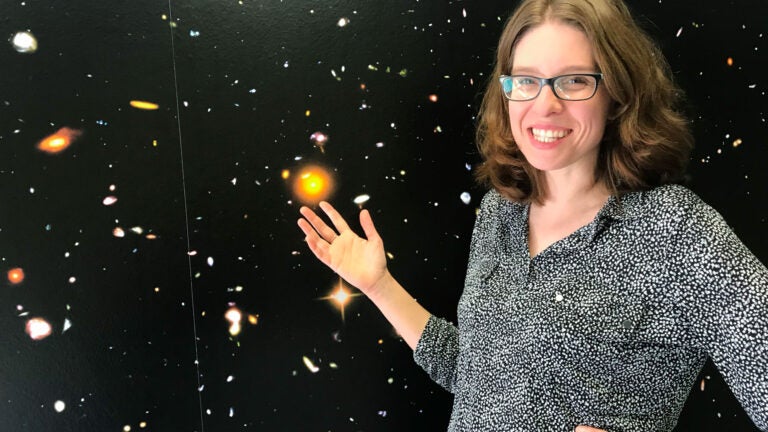
Vera Gluscevic joined the Department of Physics and Astronomy in 2019 and studies dark energy and dark matter. (USC Photo/Gary Polakovic)
USC cosmologist works to make sense of a confusing universe
Vera Gluscevic studies the deep unknowns of space — including dark matter and dark energy — while pushing to make science more open and diverse.
We live in a weird place.
The universe around us, that is. Its vastness fascinates our imagination, yet our finite minds can scarcely grasp its mysteries. That’s where Vera Gluscevic comes in.
Gluscevic is a professor in the Department of Physics and Astronomy at the USC Dornsife College of Letters, Arts and Sciences. Her office is on the fifth floor of the Ahmanson Center Building, but her lab is, well, everything everywhere.
“I find new ways of using observations spanning the entire cosmic history — from microwave background radiation from the Big Bang to dwarf galaxies around the Milky Way — to test the fundamental fabric of nature,” she said.
When people look into the night sky, they see meteors and stars and planets. Strangely, that’s a tiny part of what constitutes the universe. The real action is happening in the unseen stuff, called dark matter and dark energy.
According to NASA, only 5% of the universe consists of material objects, the heavenly bodies we see in the night sky. The rest of space — in fact, nearly all of it — consists of dark matter and dark energy. They are the new and unknown substances that drive the evolution of the universe.
I find new ways of using observations spanning the entire cosmic history … to test the fundamental fabric of nature.
Vera Gluscevic
Dark matter and dark energy comprise 27% and 68% of the universe, respectively. They are shaping the universe we observe, but the forces at work defy physics and confound scientists.
So, Gluscevic and her students, colleagues and collaborators at other universities are trying to make sense of this invisible side of the universe.
On a typical day, Gluscevic teaches a class, meets with students, talks with collaborators, writes some computer code and works on research. On a good day, her team finds a missing factor in equations, resolves a bug in code or figures out how to better solve a problem. A great day means a wholly new idea surfaces, sparking a new project and a new collaboration.
“And if I’ve also helped make our institutional policies more progressive and supportive of open and diverse science, then I’m in professional heaven of accomplishment,” she said.
USC cosmologist seeks to understand dark energy
To understand the universe, you have to start at the Big Bang roughly 13.8 billion years ago, when the universe began to expand. Until recently, scientists figured that gravity would eventually exert its force and slow the expansion, after which the universe might go in reverse to compress upon itself. Then, in 1998 the Hubble Telescope observed that supernovae from the distant past were expanding slower than the present universe, proving that today’s universe is expanding faster and rapidly pulling galaxies apart.
“If you launched a ball into the atmosphere, it will either go up and then turn around and come back down. Or if you launch it fast enough, it will travel to outer space and continue at a constant velocity,” Gluscevic explained. “But what the ball will never do is accelerate faster and faster, the farther it gets from Earth. And that’s what the galaxies are doing now. The farther away they are from each other, the faster they go.”
But how could this be? Maybe there is something wrong with the theory of gravity. Or maybe other forces were at work in the universe to overcome gravity’s pull on objects. Dark energy is the term for those forces.
Dark energy is invisible and hard to study, so scientists measure it indirectly, using mathematical computations. They investigate how it influences light, galaxies and other visible things to make inferences. It is the ultimate big data project.
At stake are questions that have bedeviled scientists, philosophers and theologians for centuries: What’s out there in space? What are the laws of nature? What’s the fate of the cosmos and everything therein, including us?
Some scientists say dark energy is an inherent energy of an empty space with an amount that theories fail to predict correctly. Some say it’s a new kind of a field or a new particle. Either way, it’s something unseen in physics before, something that dictates how the entire universe expands.
“Imagine expansion of the universe as the expansion of the surface of an inflating balloon, but a balloon in three dimensions. Across the balloon, every point is receding from every other point, just like every galaxy is receding from every other galaxy in our universe,” Gluscevic explained.
Vera Gluscevic researches the clues found in dwarf galaxies
It’s also possible that empty space is full of ephemeral quantum particles, which could explain why galaxies seem to be a lot heavier than their stars alone. But this dark matter isn’t like the normal matter we are made out of. Scientists acknowledge they don’t understand this very well, but they focus on certain places for clues.
One clue could be found in dwarf galaxies, many of which happen to be in the orbit of the Milky Way, which are also a focus of Gluscevic’s research. The primordial universe consisted of a smooth sea of particles with tiny bumps of infant galaxies. Dark matter prevailed in those new galaxies, “so we look to these smallest galaxies to do a kind of ‘particle archeology’ to reconstruct the identity of particles we can’t study in a laboratory,” she said.
Cosmology is bound for an exciting journey in the coming decade.
Gluscevic
Whatever the answer, solutions will depend on more observations, more computations and more analyses. Data is flooding in from numerous astrophysical and cosmological surveys of unprecedented scale, among them projects at the Vera C. Rubin Observatory, the first U.S. observatory named after a woman, and the Simons Observatory in Chile, which collaborates with USC.
“By the sheer amount of things we’ll learn from the new data, I’d say prospects are as good as they’ve ever been that we’ll be able to answer questions like, ‘what is dark matter and dark energy?’” Gluscevic said. “We might stumble upon new and unexpected discoveries that will force us to redefine our inquiry and advance our knowledge. Cosmology is bound for an exciting journey in the coming decade.”
How Gluscevic went from Belgrade to Los Angeles
Gluscevic’s journey to USC began as a girl growing up in Belgrade. She can’t pinpoint when science captured her imagination. Perhaps when she watched microbes swimming under the illumination of her father’s microscope, or maybe it was some C-grade movie about a heroine scientist who saved the Earth from a comet. That was “the first time I heard the word ‘astrophysicist.’ I thought that was pretty cool,” she said.
According to the UNESCO Institute for Statistics, less than 30% of the world’s researchers are women. It’s a long-standing gender gap in sharp relief during Women’s History Month in March.
Yet, in socialist Yugoslavia women were encouraged to go to college, study science and get careers. Female scientist role models were common throughout her early career in Serbia, Gluscevic said, which sealed her sense of belonging in science.
Through a combination of luck, hard work and smarts, she went to Caltech, where she earned her doctorate degree in astrophysics in 2013. She joined the USC faculty in August 2019, a time of change and reform for the university.
“USC is diverse, and it’s looking upward now,” Gluscevic said. “I like what I hear from new leadership, their commitment to change, and I want to help improve things. I’m glad to be a part.”



